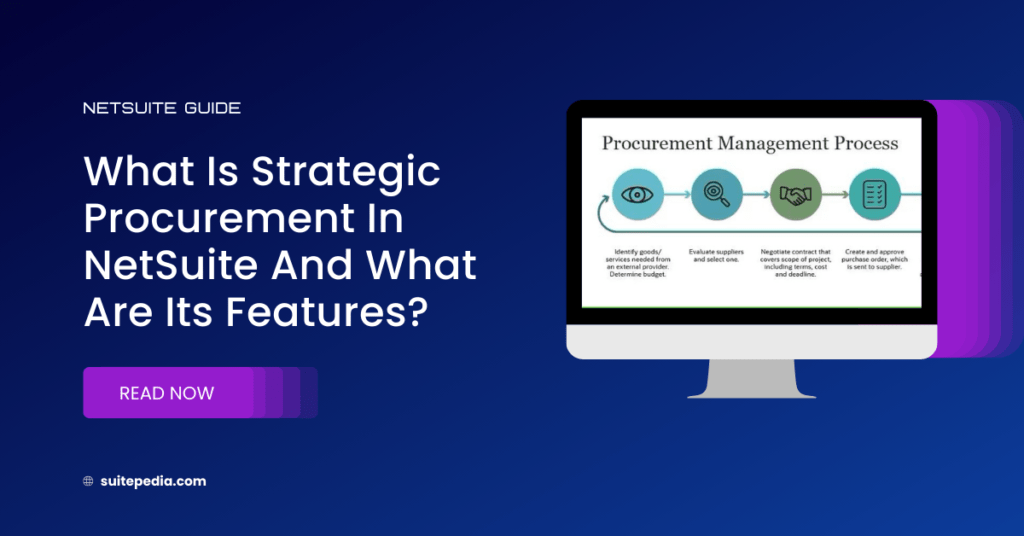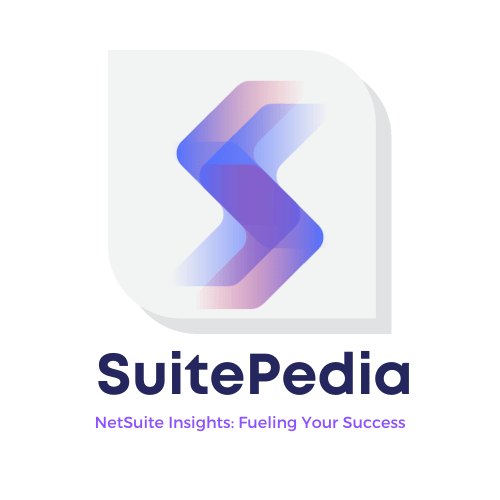What Is Procurement In NetSuite? Types, Process, & LifeCycle
NetSuite procurement module is a fundamental business function that involves the acquisition of goods, services, or raw materials necessary for an organization to achieve its objectives and deliver its products or services. It is a critical component of supply chain management and plays a pivotal role in the success and sustainability of businesses across various industries. Strategic Procurement is about more than that.

What Is Procurement Software?
Procurement software in NetSuite refers to a comprehensive solution designed to streamline and automate the procurement process within the NetSuite ERP (Enterprise Resource Planning) system. NetSuite’s procurement software facilitates efficient purchasing activities, from requisition to payment, helping organizations optimize their procurement workflows.
This software empowers businesses with tools for supplier management, purchase order creation, approvals, and invoice processing. With real-time visibility into procurement data, users can make informed decisions, monitor spending, and enforce compliance. NetSuite’s procurement software also integrates seamlessly with other modules like inventory management and financials, ensuring a cohesive and synchronized approach to business operations.
By leveraging NetSuite’s procurement software, organizations can enhance efficiency, reduce manual errors, and gain better control over their procurement processes, ultimately contributing to improved operational excellence and cost savings.
Why Is Procurement Important in Business?
NetSuite procurement module plays a pivotal role in business operations, serving as a cornerstone for organizational success and sustainability. Effective procurement ensures that businesses acquire the necessary goods, services, and resources at optimal costs, quality, and timing. By strategically managing procurement processes, companies can achieve several critical objectives.
- Cost Management: Procurement ensures optimal acquisition of goods and services, leading to competitive pricing, favorable terms, and reduced expenses, thereby enhancing profitability.
- Risk Mitigation: Strategic procurement practices diversify suppliers and address potential disruptions, ensuring continuity of operations and reducing vulnerability.
- Innovation: Collaboration with suppliers can drive innovation by enhancing products, services, and responsiveness to market demands.
- Operational Efficiency: Streamlining procurement processes improves efficiency, reduces lead times, and enhances overall business performance.
- Competitive Advantage: By securing resources at optimal costs and quality, businesses can gain a competitive edge in the marketplace.
- Financial Performance: Efficient procurement directly impacts financial metrics, contributing to improved profitability and shareholder value.
- Global Landscape: In a complex global environment, effective procurement strategies enable businesses to navigate challenges, seize opportunities, and adapt to changing market conditions.
What are the types of Procurement?
In the realm of business management and operations, procurement stands as a critical function, particularly when integrated with sophisticated platforms like NetSuite. NetSuite offers various procurement types, each tailored to meet specific organizational needs, ensuring seamless and efficient operations. Below are key types of procurement in relation to NetSuite, elucidated in point format:
- Direct Procurement: Involves sourcing materials directly used in production, ensuring quality and timely availability.
- Indirect Procurement: Focuses on non-production goods and services, such as office supplies or maintenance, optimizing operational efficiency.
- Services Procurement: Manages the acquisition of external services, such as consulting or IT services, through comprehensive contract management and vendor collaboration.
- Catalog Procurement: Streamlines purchasing through predefined catalogs, ensuring compliance, and simplifying the requisition process.
- Supplier Management: Facilitates strategic supplier relationships, performance tracking, and collaboration to ensure reliability and quality.
In summary, NetSuite’s procurement functionalities encompass a range of procurement types, enabling organizations to tailor their approaches, optimize resource allocation, and drive operational excellence.
Features Of Strategic Procurement
NetSuite offers a wide range of procurement features to support efficient and effective procurement processes. Here are some of the key features in NetSuite’s procurement module:

- Purchase Order Management: Create, approve, and manage purchase orders within the system.
- Supplier Relationship Management (SRM): Track and evaluate supplier performance, negotiate terms, and manage supplier relationships.
- Requisition Management: Create and manage purchase requisitions with automated approval workflows.
- Procure-to-Pay (P2P) Automation: Streamline the entire procurement process from requisition to payment, reducing manual intervention.
- Inventory Management Integration: Integrate procurement with inventory management to optimize stock levels and minimize excess inventory.
- Spend Analysis: Analyze spending patterns and identify cost-saving opportunities.
- Compliance and Audit Trails: Ensure compliance with industry regulations and maintain detailed audit trails for procurement activities
- Mobile Access: Access procurement functions on mobile devices for on-the-go approval and tracking.
- Multi-subsidiary Support: Manage procurement for multiple subsidiaries or business units within a single instance.
- Purchase Order Automation: Automate the creation and approval of purchase orders to reduce errors and save time
- Vendor Self-Service Portals: Provide suppliers with self-service portals to submit invoices, check payment status, and update information.
- Advanced Reporting and Analytics: Generate reports and analyze procurement data to make data-driven decisions.
- Integration Capabilities: Integrate with other systems and applications, such as e-commerce platforms and CRM systems, for a unified procurement solution.
- Global Procurement Support: Handle procurement activities for global operations, including multi-currency and multi-language support.
- Cost Control: Implement cost control measures, negotiate favorable terms with suppliers, and reduce unnecessary spending.
- Procurement Dashboards: Access customizable dashboards to view key procurement metrics at a glance.
- Document Management: Store and manage procurement-related documents and contracts.
- Approval Workflows: Set up automated approval workflows for purchase requests, orders, and invoices.
- Supplier Collaboration: Collaborate with suppliers to ensure on-time delivery, quality products, and efficient communication.
These features collectively enable organizations to manage their procurement processes more efficiently, control costs, and improve supplier relationships while ensuring compliance with industry regulations and internal policies.
What is Procurement Process?
Navigating the complexities of procurement is paramount for businesses aiming for operational efficiency and cost-effectiveness, especially when leveraging advanced platforms like NetSuite. NetSuite offers a streamlined procurement process that encompasses various stages, ensuring organizations can manage their purchasing activities with precision and agility. Here’s a breakdown of the procurement process in relation to NetSuite:
- Requisition Management: Initiates the procurement cycle by capturing internal requirements, enabling stakeholders to request goods or services.
- Supplier Selection: Facilitates the evaluation and selection of suppliers based on predefined criteria, ensuring alignment with organizational goals and quality standards.
- Purchase Order Generation: Automates the creation and issuance of purchase orders, specifying terms, quantities, and delivery timelines.
- Receipt and Inspection: Tracks the receipt of goods or services, enabling quality inspections, and ensuring compliance with purchase orders.
- Invoice Processing: Streamlines invoice verification, approval, and payment processes, enhancing financial accuracy and transparency.
- Reporting and Analytics: Provides real-time visibility into procurement metrics, enabling data-driven decision-making and continuous improvement.
In essence, NetSuite’s procurement process offers a comprehensive framework that integrates seamlessly with organizational workflows, fostering efficiency, compliance, and strategic supplier management.
What are the Stages of Procurement?
In today’s dynamic business environment, mastering the procurement stages is crucial for optimizing resources and ensuring operational excellence, particularly when utilizing sophisticated platforms like NetSuite. NetSuite provides a structured approach to procurement, encompassing distinct stages that facilitate seamless and efficient purchasing processes. Here’s a concise breakdown of the stages of procurement in relation to NetSuite:
- Demand Planning: Identifies and forecasts organizational requirements, laying the foundation for informed purchasing decisions.
- Supplier Evaluation: Assesses potential suppliers based on criteria such as quality, reliability, and cost-effectiveness, ensuring alignment with organizational objectives.
- Contract Negotiation: Facilitates the negotiation of terms, pricing, and conditions with selected suppliers, establishing mutually beneficial agreements.
- Order Processing: Streamlines the creation, approval, and issuance of purchase orders, specifying details such as quantities, delivery dates, and payment terms.
- Receipt and Inspection: Manages the receipt of goods or services, conducting quality inspections and verifying compliance with purchase specifications.
- Invoice Verification and Payment: Automates invoice reconciliation, approval, and payment processes, ensuring accuracy, transparency, and timely settlement.
NetSuite’s procurement stages provide a structured framework that enables organizations to navigate the procurement lifecycle effectively, fostering strategic supplier relationships and driving operational efficiency.
What is Procurement Life Cycle?
Understanding the procurement life cycle is pivotal for businesses aiming to optimize resources, enhance efficiency, and foster strategic partnerships, especially when utilizing advanced platforms like NetSuite. NetSuite offers a comprehensive procurement life cycle framework that guides organizations through every stage of the purchasing process. Here’s a breakdown of the procurement life cycle in relation to NetSuite, presented in point format:
- Requirement Identification: Defines organizational needs and objectives, initiating the procurement process with clarity and purpose.
- Supplier Selection and Onboarding: Evaluates potential suppliers, negotiates contracts, and establishes partnerships that align with quality, cost, and delivery expectations.
- Purchase Order Management: Automates the creation, approval, and issuance of purchase orders, ensuring accurate specifications and timely procurement.
- Receipt and Inspection: Manages the receipt of goods or services, conducts quality assessments, and verifies compliance with contractual agreements.
- Invoice Processing: Streamlines invoice verification, approval, and payment processes, enhancing financial transparency and compliance.
- Performance Evaluation: Monitors supplier performance, assesses key metrics, and fosters continuous improvement through collaboration and feedback.
In essence, NetSuite’s procurement life cycle provides a holistic approach that integrates seamlessly with organizational workflows, driving efficiency, compliance, and strategic sourcing initiatives.
You can also read: NetSuite’s Purchase Workflow: Ordering Requisitions In Bulk
Note
Always refer to the official NetSuite documentation for detailed and specific guidance based on your NetSuite version. Additionally, you may want to involve your NetSuite administrator or seek assistance from NetSuite support for any specific challenges you encounter during the setup process.
